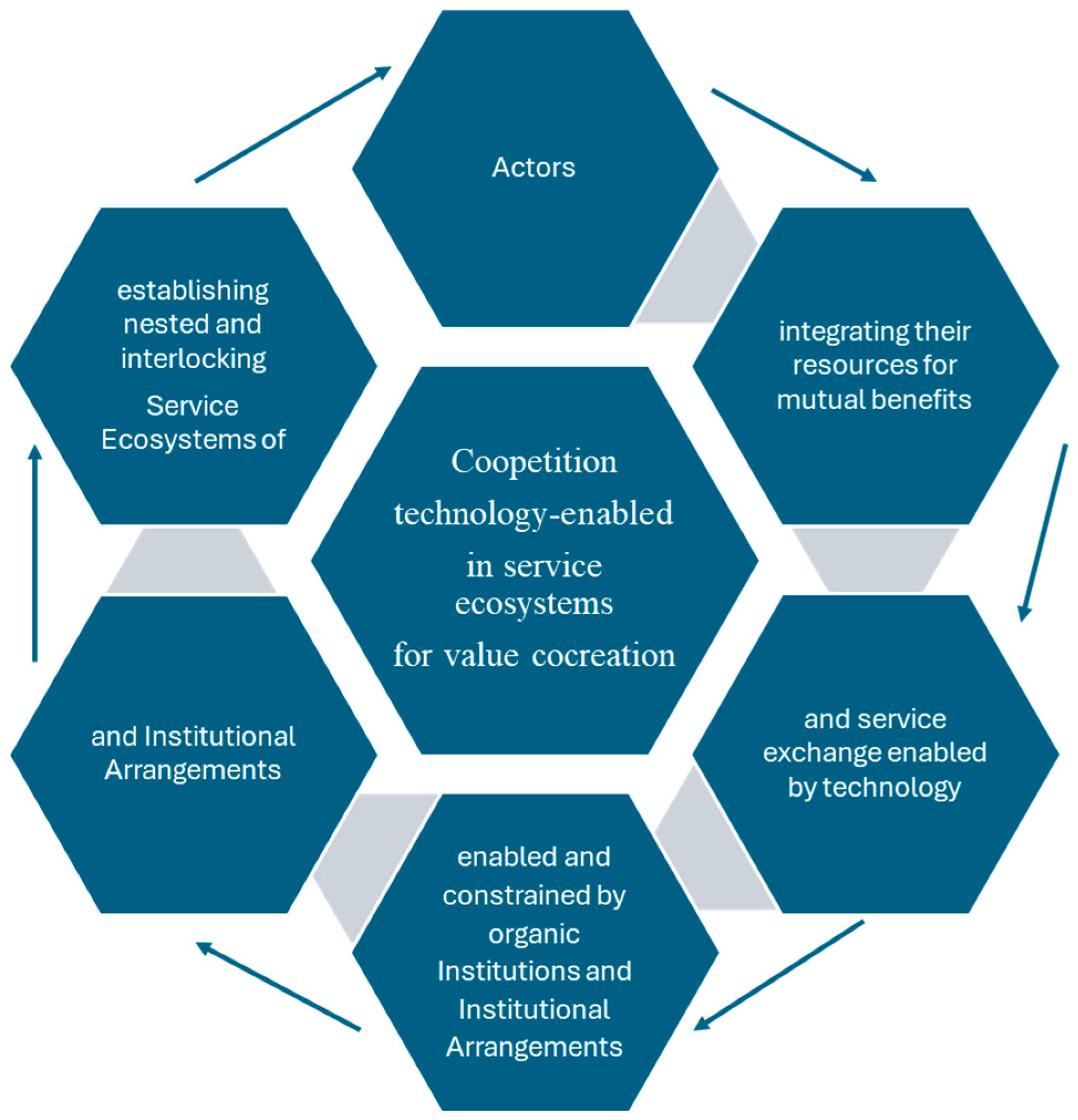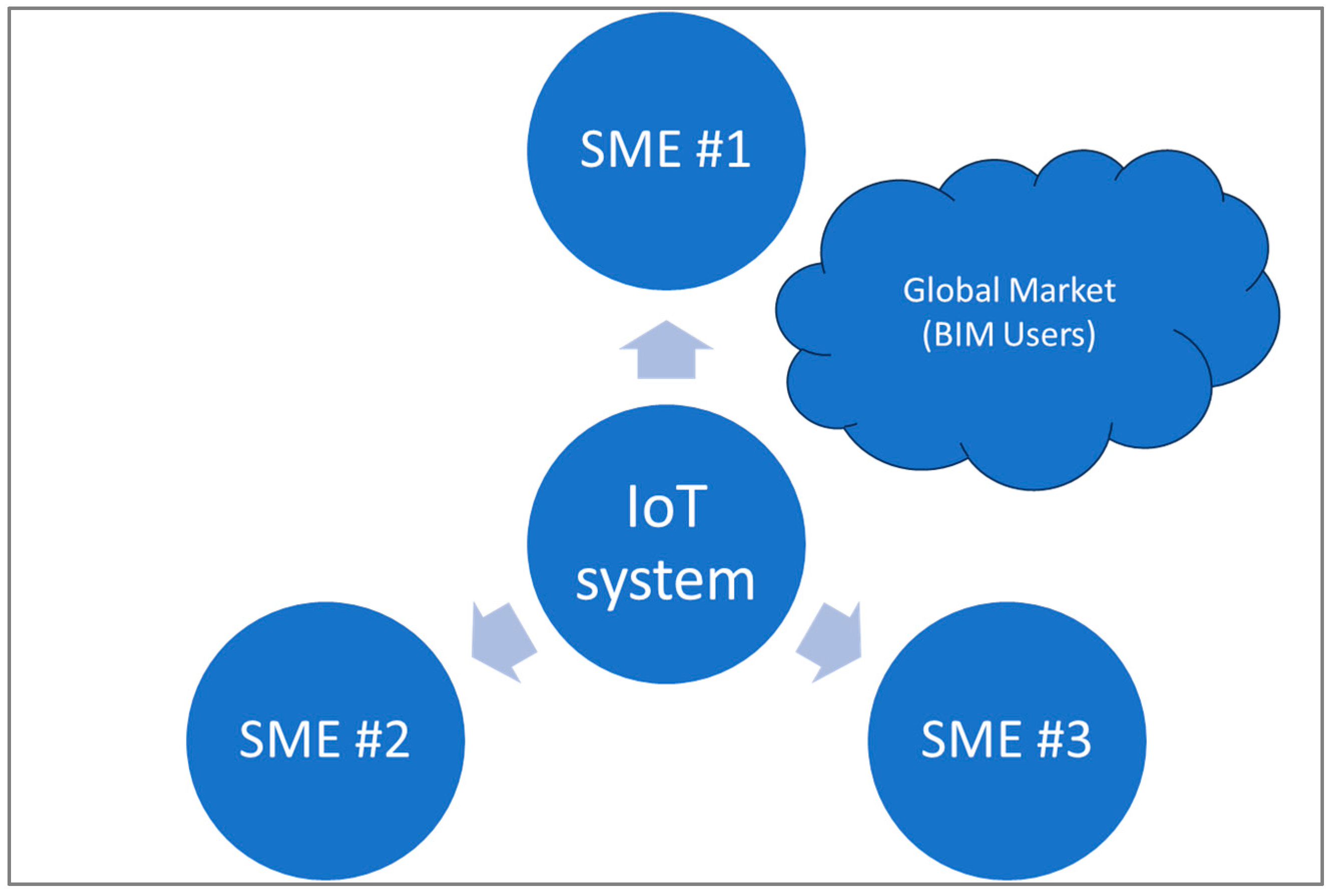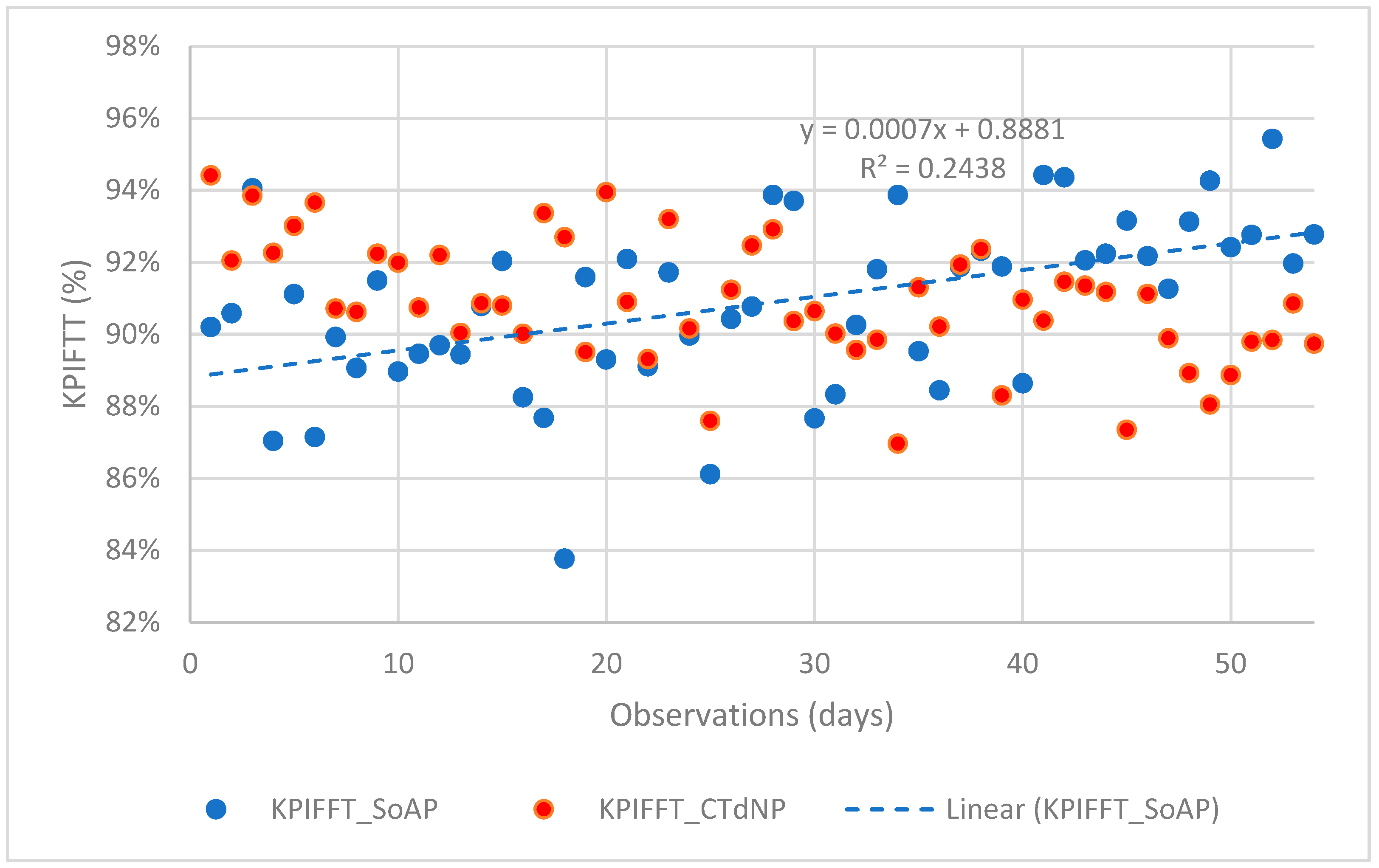Value Creation in Technology-Driven Ecosystems: Role of Coopetition in Industrial Networks
Abstract
:1. Introduction
2. Literature Review
2.1. Approaches to Coopetition
2.2. Value Creation Mechanisms in Coopetition Networks (Research Gap 1)
2.3. The Role of Technology in Coopetition Networks (Research Gap 2)
2.4. Approaching Coopetition through Service-Dominant Logic
2.5. The Role of Technology in Value Networks
3. Research Design of a Technology-Driven Framework for Coopetition Networks
3.1. Framing Networks and Ecosystems
3.2. Framing Coopetition and Value Creation
3.3. Systemic Convergence on Coopetition, Networks, and Value Co-Creation
4. Addressing Research Gaps in the Light of S-D Logic
4.1. Value Creation Mechanisms in Coopetition Networks
4.2. The Role of Technology in Coopetition Networks
4.3. Framing Technology-Driven Coopetition Networks
5. Experimental Technology-Driven Coopetition Network and Hypothesis Testing
5.1. Implementation of the Experimental Technology-Driven Coopetition Network
5.2. Evaluation Metrics
5.3. Data Collection, Results, and Discussion
6. Conclusions
Author Contributions
Funding
Institutional Review Board Statement
Informed Consent Statement
Data Availability Statement
Conflicts of Interest
References
- Meena, A.; Dhir, S.; Sushil, S. A review of coopetition and future research agenda. J. Bus. Ind. Mark. 2023, 38, 118–136. [Google Scholar] [CrossRef]
- Rouyre, A.; Fernandez, A.-S.; Bruyaka, O. Big problems require large collective actions: Managing multilateral coopetition in strategic innovation networks. Technovation 2024, 132, 102968. [Google Scholar] [CrossRef]
- Crick, J. The dark side of coopetition: When collaborating with competitors is harmful for company performance. J. Bus. Ind. Mark. 2019, 35, 318–337. [Google Scholar] [CrossRef]
- Reeves, M.; Lotan, H.; Legrand, J.; Jacobides, M.G. How Business Ecosystems Rise (and Often Fall). MIT Sloan Manag. Rev. 2019, 27–34. [Google Scholar] [CrossRef]
- Corbo, L.; Kraus, S.; Vlačić, B.; Dabić, M.; Caputo, A.; Pellegrini, M.M. Coopetition and innovation: A review and research agenda. Technovation 2023, 122, 102624. [Google Scholar] [CrossRef]
- Bouncken, R.; Kumar, A.; Connell, J.; Bhattacharyya, A.; He, K. Coopetition for corporate responsibility and sustainability: Does it influence firm performance? Int. J. Entrep. Behav. Res. 2023, 30, 128–154. [Google Scholar] [CrossRef]
- Xie, Q.; Gao, Y.; Xia, N.; Zhang, S.; Tao, G. Coopetition and organizational performance outcomes: A meta-analysis of the main and moderator effects. J. Bus. Res. 2023, 154, 113363. [Google Scholar] [CrossRef]
- Vargo, S.L.; Fehrer, J.A.; Wieland, H.; Nariswari, A. The nature and fundamental elements of digital service innovation. J. Serv. Manag. 2023, 35, 227–252. [Google Scholar] [CrossRef]
- Jaakkola, E.; Kaartemo, V.; Siltaloppi, J.; Vargo, S.L. Advancing service-dominant logic with systems thinking. J. Bus. Res. 2024, 177, 114592. [Google Scholar] [CrossRef]
- da Silva, A.; Cardoso, A.J.M. Co-Opetition and the Industrial Internet of Things: A Strategic Framework for Operational Efficiency in the Portuguese Ornamental Stone Sector. Adm. Sci. Adm. Sci. 2024, 14, 125. [Google Scholar] [CrossRef]
- Nalebuff, B.J.; Brandenburger, A.M. Co-opetition: Competitive and cooperative business strategies for the digital economy. Strat. Leadersh. 1997, 25, 28–33. [Google Scholar] [CrossRef]
- Manzhynski, S.; Biedenbach, G.; Manzhynski, S.; Biedenbach, G. The knotted paradox of coopetition for sustainability: Investigating the interplay between core paradox properties. Ind. Mark. Manag. 2023, 110, 31–45. [Google Scholar] [CrossRef]
- Gnyawali, D.R.; Song, Y. Pursuit of rigor in research: Illustration from coopetition literature. Ind. Mark. Manag. 2016, 57, 12–22. [Google Scholar] [CrossRef]
- Gernsheimer, O.; Kanbach, D.K.; Gast, J. Coopetition research—A systematic literature review on recent accomplishments and trajectories. Ind. Mark. Manag. 2021, 96, 113–134. [Google Scholar] [CrossRef]
- Devece, C.; Ribeiro-Soriano, D.E.; Palacios-Marqués, D. Coopetition as the new trend in inter-firm alliances: Literature review and research patterns. Rev. Manag. Sci. 2019, 13, 207–226. [Google Scholar] [CrossRef]
- Klimas, P.; Ahmadian, A.A.; Soltani, M.; Shahbazi, M.; Hamidizadeh, A. Coopetition, Where Do You Come From? Identification, Categorization, and Configuration of Theoretical Roots of Coopetition. SAGE Open 2023, 13, 215824402210850. [Google Scholar] [CrossRef]
- Raza-Ullah, T.; Bengtsson, M.; Kock, S. The coopetition paradox and tension in coopetition at multiple levels. Ind. Mark. Manag. 2014, 43, 189–198. [Google Scholar] [CrossRef]
- Spiller, P.T. A Tribute to Oliver Williamson: Regulation: A Transaction Cost Perspective. Calif. Manag. Rev. 2010, 52, 147–158. [Google Scholar] [CrossRef]
- Parkhe, A.; Wasserman, S.; Ralston, D.A. New Frontiers in Network Theory Development. Acad. Manag. Rev. 2006, 31, 560–568. [Google Scholar] [CrossRef]
- Burga, R.; Rezania, D. Project accountability: An exploratory case study using actor–network theory. Int. J. Proj. Manag. 2017, 35, 1024–1036. [Google Scholar] [CrossRef]
- Crick, J. Moderators affecting the relationship between coopetition and company performance. J. Bus. Ind. Mark. 2019, 34, 518–531. [Google Scholar] [CrossRef]
- Kleinaltenkamp, M.; Kleinaltenkamp, M.J.; Karpen, I.O. Resource entanglement and indeterminacy: Advancing the service-dominant logic through the philosophy of Karen Barad. Mark. Theory 2023. [Google Scholar] [CrossRef]
- Amit, R.; Zott, C. Value creation in E-business. Strateg. Manag. J. 2001, 22, 493–520. [Google Scholar] [CrossRef]
- Vargo, S.L. Conceptual reconciliation for clarity and impact. AMS Rev. 2023, 13, 169–172. [Google Scholar] [CrossRef]
- Vargo, S.; Akaka, M.; Vaughan, C. Conceptualizing Value: A Service-ecosystem View. J. Creat. Value 2017, 3, 117–124. [Google Scholar] [CrossRef]
- Greer, C.R.; Lusch, R.F.; Vargo, S.L. A service perspective. Key managerial insights from service-dominant (S-D) logic. Organ. Dyn. 2016, 45, 28–38. [Google Scholar] [CrossRef]
- Vargo, S.L.; Lusch, R.F. Evolving to a New Dominant Logic for Marketing. J. Mark. 2004, 68, 1–17. [Google Scholar] [CrossRef]
- Lusch, R.F.; Vargo, S.L.; Tanniru, M. Service, value networks and learning. J. Acad. Mark. Sci. 2010, 38, 19–31. [Google Scholar] [CrossRef]
- Normann, R.; Ramírez, R. From value chain to value constellation: Designing interactive strategy. Harv. Bus. Rev. 1993, 71, 65–77. Available online: http://search.ebscohost.com/login.aspx?direct=true&db=bth&AN=9309166477&site=eds-live (accessed on 4 June 2024).
- Vargo, S.L.; Lusch, R.F. Inversions of service-dominant logic. Mark. Theory 2014, 14, 239–248. [Google Scholar] [CrossRef]
- Elo, J.; Lumivalo, J.; Tuunanen, T.; Vargo, S.L. Enabling Value Co-Creation in Partner Collaboration Ecosystems: An Institutional Work Perspective. In Proceedings of the 57th Hawaii International Conference on System Science and Engineering, Online, 3–6 January 2024; Available online: https://hdl.handle.net/10125/106412 (accessed on 2 June 2024).
- Siltaloppi, J.; Koskela-Huotari, K.; Vargo, S.L. Institutional complexity as a driver for innovation in service ecosystems. Serv. Sci. 2016, 8, 333–343. [Google Scholar] [CrossRef]
- Bouncken, R.B.; Plüschke, B.D.; Pesch, R.; Kraus, S. Entrepreneurial orientation in vertical alliances: Joint product innovation and learning from allies. Rev. Manag. Sci. 2016, 10, 381–409. [Google Scholar] [CrossRef]
- Autio, E.; Thomas, L.D.W. Innovation Ecosystems: Implications for Innovation Management; Oxford University Press: Oxford, UK, 2014. [Google Scholar]
- Antai, I. A theory of the competing supply chain: Alternatives for development. Int. Bus. Res. 2010, 4, 74–85. [Google Scholar] [CrossRef]
- Contarinis, S.; Pallikaris, A.; Nakos, B. The value of marine spatial open data infrastructures-potentials of IHO S-100 standard to become the universal marine data model. J. Mar. Sci. Eng. 2020, 8, 564. [Google Scholar] [CrossRef]
- Imschloss, M.; Schwemmle, M. Value creation in post-pandemic retailing: A conceptual framework and implications. J. Bus. Econ. 2023, 94, 851–889. [Google Scholar] [CrossRef]
- Mariotti, J. The value network. Exec. Excell. 2002, 19, 18. [Google Scholar]
- Vargo, S.L.; Lusch, R.F. Service-dominant logic 2025. Int. J. Res. Mark. 2017, 34, 46–67. [Google Scholar] [CrossRef]
- Mustak, M.; Plé, L. A critical analysis of service ecosystems research: Rethinking its premises to move forward. J. Serv. Mark. 2020, 34, 399–413. [Google Scholar] [CrossRef]
- Breidbach, C.F.; Maglio, P.P. Technology-enabled value co-creation: An empirical analysis of actors, resources, and practices. Ind. Mark. Manag. 2016, 56, 73–85. [Google Scholar] [CrossRef]
- Vargo, S.L.; Wieland, H.; O’Brien, M. Service-dominant logic as a unifying theoretical framework for the re-institutionalization of the marketing discipline. J. Bus. Res. 2023, 164, 113965. [Google Scholar] [CrossRef]
- Arthur, W.B. The Nature of Technology; Penguin Books Ltd.: London, UK, 2009. [Google Scholar]
- Matthies, B.D.; D’Amato, D.; Berghäll, S.; Ekholm, T.; Hoen, H.F.; Holopainen, J.; Korhonen, J.E.; Lähtinen, K.; Mattila, O.; Toppinen, A.; et al. An ecosystem service-dominant logic?—Integrating the ecosystem service approach and the service-dominant logic. J. Clean. Prod. 2016, 124, 51–64. [Google Scholar] [CrossRef]
- Lusch, R.F.; Nambisan, S. Service Innovation: A Service-Dominant Logic Perspective. MIS Q. 2015, 39, 155–175. [Google Scholar] [CrossRef]
- Wieland, H.; Hartmann, N.; Vargo, S. Business models as service strategy. J. Acad. Mark. Sci. 2017, 45, 925–943. [Google Scholar] [CrossRef]
- Jaakkola, E. Designing conceptual articles: Four approaches. AMS Rev. 2020, 10, 18–26. [Google Scholar] [CrossRef]
- da Silva, A.; Dionisio, A.; Almeida, I. Enabling Cyber-Physical Systems for Industry 4.0 operations: A Service Science Perspective. Int. J. Innov. Technol. Explor. Eng. 2020, 9, 838–846. [Google Scholar] [CrossRef]
- Hartmann, N.N.; Wieland, H.; Vargo, S.L. Converging on a New Theoretical Foundation for Selling. J. Mark. 2018, 82, 1–18. [Google Scholar] [CrossRef]
- Gnyawali, D.R.; Ryan Charleton, T. Nuances in the Interplay of Competition and Cooperation: Towards a Theory of Coopetition. J. Manag. 2018, 44, 2511–2534. [Google Scholar] [CrossRef]
- Lusch, R.F.; Vargo, S.L.; Gustafsson, A. Fostering a trans-disciplinary perspectives of service ecosystems. J. Bus. Res. 2016, 69, 2957–2963. [Google Scholar] [CrossRef]
- Ruokolainen, T.; Kutvonen, L. Managing interoperability knowledge in open service ecosystems. In Proceedings of the IEEE International Enterprise Distributed Object Computing Conference (EDOC), Washington, DC, USA, 1–4 September 2009; pp. 203–211. [Google Scholar] [CrossRef]
- Ruokolainen, T.; Ruohomaa, S.; Kutvonen, L. Solving service ecosystem governance. In Proceedings of the 21st IEEE International Enterprise Distributed Object Computing Conference (EDOC), Helsinki, Finland, 29 August–2 September 2011; pp. 18–25. [Google Scholar] [CrossRef]
- Vargo, S.L.; Lusch, R.F. It’s all B2B… and beyond: Toward a systems perspective of the market. Ind. Mark. Manag. 2011, 40, 181–187. [Google Scholar] [CrossRef]
- Koskela-Huotari, K.; Vink, J.; Edvardsson, B. The institutional turn in service research: Taking stock and moving ahead. J. Serv. Mark. 2020, 34, 373–387. [Google Scholar] [CrossRef]
- CSeepana, C.; Paulraj, A.; Huq, F.A. The architecture of coopetition: Strategic intent, ambidextrous managers, and knowledge sharing. Ind. Mark. Manag. 2020, 91, 100–113. [Google Scholar] [CrossRef]
- Akaka, M.; Schau, H.; Vargo, S. How Practice Diffusion Drives IoT Technology Adoption and Institutionalization of Solutions in Service Ecosystems. In Proceedings of the Annual Hawaii International Conference on System Sciences, Big Island, Hawaii, USA, 3–6 January 2023; pp. 1427–1435. [Google Scholar] [CrossRef]
- Scott, W. Institutions and Organizations; SAGE Publications, Inc.: Thousand Oaks, CA, USA, 2001. [Google Scholar]
- Lawrence, T.; Suddaby, R. Institutions and Institutional Work. In The SAGE Handbook of Organization Studies: Chapter 6; SAGE Publications, Inc.: Thousand Oaks, CA, USA, 2006. [Google Scholar]
- Vargo, S.; Lusch, R. Institutions and axioms: An extension and update of service-dominant logic. J. Acad. Mark. Sci. 2016, 44, 5–23. [Google Scholar] [CrossRef]
- Rindfleisch, A.; Moorman, C. Interfirm Cooperation and Customer Orientation. J. Mark. Res. 2003, 40, 421–436. [Google Scholar] [CrossRef]
- Vargo, S.; Lusch, R. The SAGE Handbook of Service-Dominant Logic; SAGE Publications, Inc.: Thousand Oaks, CA, USA, 2018. [Google Scholar] [CrossRef]
- Scott, W. Institutions and Organizations—Ideas, Interests, and Identities; SAGE Publications, Inc.: Thousand Oaks, CA, USA, 2013. [Google Scholar]
- SBarile, S.; Lusch, R.; Reynoso, J.; Saviano, M.; Spohrer, J. Systems, Networks, and Ecosystems in Service Research. J. Serv. Manag. 2016, 34, 1–5. [Google Scholar] [CrossRef]
- Chandler, J.D.; Danatzis, I.; Wernicke, C.; Akaka, M.A.; Reynolds, D. How Does Innovation Emerge in a Service Ecosystem? J. Serv. Res. 2019, 22, 75–89. [Google Scholar] [CrossRef]
- Uribe, J.; Sytch, M.; Kim, Y.H. When Friends Become Foes: Collaboration as a Catalyst for Conflict. Adm. Sci. Q. 2020, 65, 751–794. [Google Scholar] [CrossRef]
- Di Bella, L.; Katsinis, A.; Lagüera-González, J.; Odenthal, L.; Hell, M.; Lozar, B. Annual Report on European SMEs 2022/2023; European Union: Maastricht, The Netherlands, 2023. [Google Scholar]
- Razmdoost, K.; Alinaghian, L.; Chandler, J.D.; Mele, C. Service ecosystem boundary and boundary work. J. Bus. Res. 2023, 156, 113489. [Google Scholar] [CrossRef]
- Vargo, S.L.; Peters, L.; Kjellberg, H.; Koskela-Huotari, K.; Nenonen, S.; Polese, F.; Sarno, D.; Vaughan, C. Emergence in marketing: An institutional and ecosystem framework. J. Acad. Mark. Sci. 2023, 51, 2–22. [Google Scholar] [CrossRef]
- Carvalho, J.M.F.; Lisboa, J.V. Ornamental stone potential areas for land use planning: A case study in a limestone massif from Portugal. Environ. Earth Sci. 2018, 77, 206. [Google Scholar] [CrossRef]
- Silva, A.; Marques Cardoso, A. BIM-based Supply Chain in AEC—Threats on the Portuguese Stone sector. In Proceedings of the 7th Globalstone Congress, Batalha, Portugal, 18–23 June 2023; ISBN 978-972-778-327-4. Available online: https://repositorio.lneg.pt/bitstream/10400.9/4150/1/GSC2023_PT%20Natural%20Stones-Commercial%20Names%20harmonization.pdf (accessed on 2 June 2024).
- Silva, A.; Pata, A. Value Creation in Technology Service Ecosystems—Empirical Case Study. In Innovations in Industrial Engeneering II; Springer: Berlin/Heidelberg, Germany, 2022; pp. 26–36. [Google Scholar] [CrossRef]
- Chen, Z.-S.; Wang, Z.-R.; Deveci, M.; Ding, W.; Pedrycz, W.; Skibniewski, M.J. Optimization-based probabilistic decision support for assessing building information modelling (BIM) maturity considering multiple objectives. Inf. Fusion 2024, 102, 102026. [Google Scholar] [CrossRef]
- Shao, S.; Cao, D. Contagion of BIM Implementation Practices in Interproject Networks: An Empirical Study in China. J. Manag. Eng. 2024, 40, 05023009. [Google Scholar] [CrossRef]
- Lakshmanan, R.; Nyamekye, P.; Virolainen, V.-M.; Piili, H. The convergence of lean management and additive manufacturing: Case of manufacturing industries. Clean. Eng. Technol. 2023, 13, 100620. [Google Scholar] [CrossRef]




| Data ID | Description | SoAP | CTdNP |
|---|---|---|---|
| Data 1 | Parts Produced | 369.9 | 454.3 |
| Data 2 | Defective Parts | 37.3 | 38.5 |
| KPIFTT | (%) | 90.9% | 91.4% |
Disclaimer/Publisher’s Note: The statements, opinions and data contained in all publications are solely those of the individual author(s) and contributor(s) and not of MDPI and/or the editor(s). MDPI and/or the editor(s) disclaim responsibility for any injury to people or property resulting from any ideas, methods, instructions or products referred to in the content. |
© 2024 by the authors. Licensee MDPI, Basel, Switzerland. This article is an open access article distributed under the terms and conditions of the Creative Commons Attribution (CC BY) license (https://creativecommons.org/licenses/by/4.0/).
Share and Cite
da Silva, A.; Cardoso, A.J.M. Value Creation in Technology-Driven Ecosystems: Role of Coopetition in Industrial Networks. J. Theor. Appl. Electron. Commer. Res. 2024, 19, 2343-2359. https://doi.org/10.3390/jtaer19030113
da Silva A, Cardoso AJM. Value Creation in Technology-Driven Ecosystems: Role of Coopetition in Industrial Networks. Journal of Theoretical and Applied Electronic Commerce Research. 2024; 19(3):2343-2359. https://doi.org/10.3390/jtaer19030113
Chicago/Turabian Styleda Silva, Agostinho, and António J. Marques Cardoso. 2024. "Value Creation in Technology-Driven Ecosystems: Role of Coopetition in Industrial Networks" Journal of Theoretical and Applied Electronic Commerce Research 19, no. 3: 2343-2359. https://doi.org/10.3390/jtaer19030113
APA Styleda Silva, A., & Cardoso, A. J. M. (2024). Value Creation in Technology-Driven Ecosystems: Role of Coopetition in Industrial Networks. Journal of Theoretical and Applied Electronic Commerce Research, 19(3), 2343-2359. https://doi.org/10.3390/jtaer19030113







